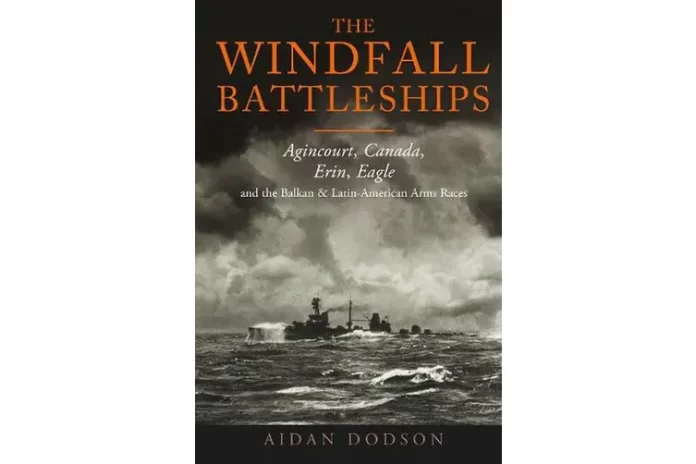
The Windfall Battleships – Agincourt, Canada, Erin, Eagle and the Balkan and Latin- American Arms Race. By Aidan Dodson. Seaforth Publishing Barnsley 2023.
Reviewed by John Mortimer
The author has co-written several books on warships of the First and Second World War, including “The Fate of Enemy Fleets after the Two World Wars” with Serena Cant and “The Kaiser’s Cruisers 1871-1918” with Dirk Nottlemann. He also wrote “The Kaiser’s Battlefleet – German Capital Ships 1871-1918”.
This current book adds a further dimension to the author’s earlier publications with a wide- ranging study of the four battleships ordered from British shipyards prior to the First World War. Four battleships under construction on the Tyne in 1914 were the Sultan Osman 1 ordered by Brazil but sold the previous year to Turkey, the Chilean Almirante Latorre and Almirante Cochrane, and the Brazilian Riachuelo. These four ships would eventually enter service with the Royal Navy as Agincourt, Erin, Canada, and Eagle, respectively. The author traces the history of the acquisition of these ships, and examines their characteristics and performance compared to other contemporary British battleships. The author rounds out his discussion by covering other classes of warship building in Britain and by other major naval powers at the time for foreign countries, mainly from South American, Europe and Asia. As such the book covers a wide array of naval construction work being undertaken prior to the First World War.
This is followed by a chapter on “The Latin-American Connection”, where the author discusses the growth of the three main Latin American navies, Argentina, Brazil and Chile, with particular emphasis on the source of their warships, major developments and the conflicts among South American navies. Some 45 pages of text and photos are provided on this subject.
The following Chapter on “The Balkan Connection” covers the Ottoman Empire and Greece, in considerable detail, as well as a few paragraphs on Romania and Bulgaria. The discussion of the Ottoman Navy and Greek Navy is particularly illuminating. There is a fascinating extract from a report submitted to the First Lord of the Admiralty by Armstrong and Vickers on 17 November 1914, which details the material state and deficiencies of a range of Ottoman warships.
This is followed by chapters on the operations of the three battleships with the Grand Fleet during the war and the later decision to convert Eagle to an aircraft carrier. Her subsequent carrier up until her loss on 11 August 1942 is covered.
Concluding chapters address the disposal of ships and the transfer of the Canada and destroyers to Chile, and the on-going service of selected Brazilian and Argentinian capital and some lesser ships.
The text is complemented by an appendix on “Warships under Construction for Foreign Customers in August 1914 by shipbuilder”, and a similar appendix on ships being built for Country of purchaser.
This book is more than one which confines itself to the four Windfall Battleships. It explores the growth of smaller navies and their attempts to generate modern naval forces in a period of rapid technological change. I found the analysis of the South American, Greek and Turkish navies particularly informative, and it provides an interesting comparison to the early development of the Royal Australian Navy and its acceptance of the Fleet Unit concept as its basis prior to the First World War. Later this would evolve into the creation of a force which could contribute to Imperial Defence, or support of a major and powerful friend. We largely remain in that vein, despite our economic growth and desire at times to play a more independent role globally.


